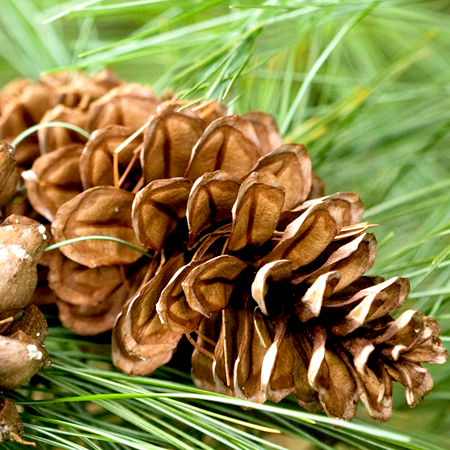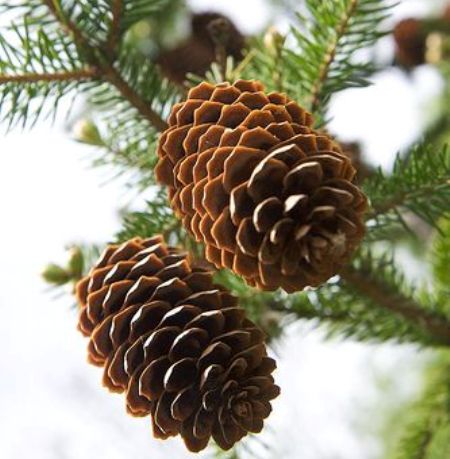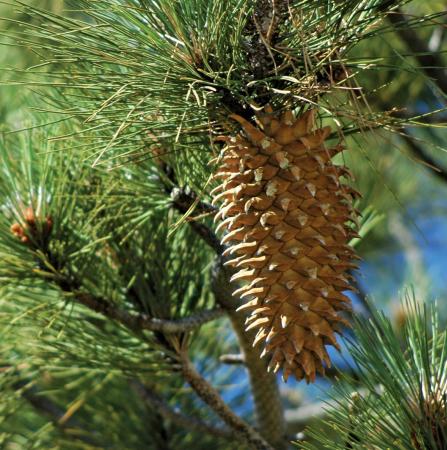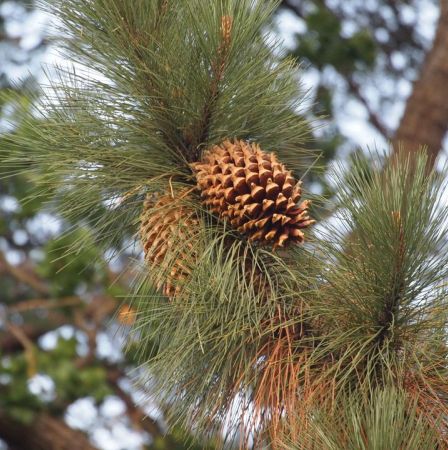





Botanical name Pinus sylvestris
Family Pinaceae
Source Needles (leaves)
Origin Hungary
Processing Method Steam Distilled
Color/Consistency A thin, colorless to pale yellow liquid.
Aromatic Summary / Note / Strength of Aroma A top note with a strong aroma, Pine Organic Essential Oil has a fresh forest smell.
Blends With Citronella, Clary Sage, Coriander, Cypress, Eucalyptus, Frankincense, Juniper, Lavender, Myrrh, Rose Mary, Spikenard and Tea Tree.
Product Abstract
Pine essential oil is obtained from the tree commonly known as pine, which has the scientific name Pinus Sylvestris. It is believed that this tree originated in Austria and Russia before spreading to different parts of the world. If you are still not sure what tree we are referring to, you have probably seen it used as a Christmas tree all over the world! One of the reasons that pine oil has become such an important element in supplemental health is its availability. It is relatively easy to make pine essential oil, and pine trees grow in huge numbers all over the world.
History
Pinus sylvestris is an evergreen coniferous tree growing up to 35 m in height and 1 m trunk diameter when mature, exceptionally over 45 metres (148 ft) tall and 1.7 metres (5 ft 7 in) trunk diameter on very productive sites, the tallest on record being a more than 210-year-old tree growing in Estonia which stands at 46.6 m (152 ft 11 in).
The bark is thick, scaly dark grey-brown on the lower trunk, and thin, flaky and orange on the upper trunk and branches. The habit of the mature tree is distinctive due to its long, bare and straight trunk topped by a rounded or flat-topped mass of foliage. The lifespan is normally 150–300 years, with the oldest recorded specimens in Lapland, Northern Finland over 760 years.
Harvesting/Extraction Information
Pine essential oil is obtained using steam distillation. Fresh twigs and needles are most often used for extracting the oil. Pine cones are also used by many manufacturers for obtaining the oil, and since pine trees are so abundant in nature, the oil is very cheap and widely available.
Common Usage
Caution
Dilute well before use; for external use only. May cause skin irritation in some individuals; a skin test is recommended prior to use. Contact with eyes should be avoided.
Key constituents
a-Pinene 21.3–44.8%
b-Pinene 1.9–33.3%
d-3-Carene 0.4–31.8%
b-Phellandrene 0.3–11.7%
d-Cadinene tr–08.6%
g-Cadinene tr–6.5%
(þ)-Limonene 0.6–8.3%
Caryophyllene oxide 0–3.8%
Bornyl acetate 0–5.1%
b-Myrcene 3.1–4.5%
b-Caryophyllene 0.8–4.9%
Longifolene 0–4.4%
a-Terpinene 0.1–4.1%
Terpinolene tr–4.0%
1,8-Cineole 0–3.8%
Chamazulene 0–1.6%
(E)-b-Ocimene 0–1.4%
Germacrene D 0–.8%
T-Muurolol 0–2.0%
Sabinene 0–0.1%
Quality Pine needle oils may be adulterated with turpentine oil, mixtures of terpenes such as a-pinene, camphene and (þ)-limonene, and esters such as ()-bornyl acetate and isobornyl acetate.
Safety summary
Hazards Skin sensitization if oxidized.
Cautions Old or oxidized oils should be avoided.
Our safety advice
Because of its a-pinene and d-3-carene content we recommend that oxidation of Scots pine oil is avoided by storage in a dark, airtight container in a refrigerator. The addition of an antioxidant to preparations ontaining it is recommended. Regulatory guidelines The Expanded Commission E Monographs lists Scots pine oil as being contraindicated in bronchial asthma and whooping cough. Essential oils derived from the Pinaceae family, including Pinus and Abies genera, should only be used when the level of peroxides is kept to the lowest practicable level, for example by the addition of antioxidants at the time of production.
Organ-specific effects
Adverse skin reactions Undiluted Scots pine oil was not irritating to rabbit, pig or mouse skin; tested at 12% on 25 volunteers it was neither irritating nor sensitizing. It is non-phototoxic. In a study of 200 consecutive dermatitis patients, four were sensitive to 2% ‘pine needle oil’ on patch testing. Autoxidation products of a-pinene and d-3-carene can cause skin sensitization.
Reproductive toxicity The low reproductive toxicity of apinene, b-pinene, b-myrcene and (þ)-limonene suggests that Scots pine oil is not hazardous in pregnancy.
Systemic effects
Acute toxicity, human: Ingestion of 400–500 mL of pine oil with suicidal intent has been survived following hemodialysis and hemoperfusion. Pine seems to possess very low toxicity with a human lethal dose reported as 60–120 mL. The unidentified pine oil comprised 57% a-pinene, 26% d-3-carene, 8% bpinene, 6% (þ)-limonene and 3% other hydrocarbons. Several cases of pine oil cleaner ingestion are known. This product contains 20–35% pine oil and various ingredients described as ‘inert’. The main toxic manifestations were mucous membrane and gastrointestinal irritation, CNS depression, ataxia and pneumonitis. Recovery was typically rapid and ingesting the cleaner was not considered to be life-threatening.
Acute toxicity, animal Scots pine needle oil acute oral LD50 in rats >5 g/kg; acute dermal LD50 in rabbits >5 g/kg.
Carcinogenic/anticarcinogenic potential Scots pine needle oil was genotoxic to fruit flies and weakly induced chromosome aberrations in human lymphocytes. The oil contains no known carcinogens. (þ)-Limonene and a-caryophyllene display anticarcinogenic activitya-cadinol is active against the human colon cancer cell line HT-2.
Comments
There is considerable variation between different Scots pine needle oils. There are possibly two chemotypes, a b-pinene and a d-3-carene. Pine needle oils may be adulterated with turpentine oil, with mixtures of camphene, pinene and bornyl acetate, or with other chemicals.